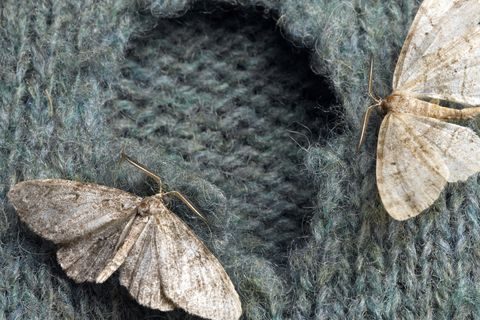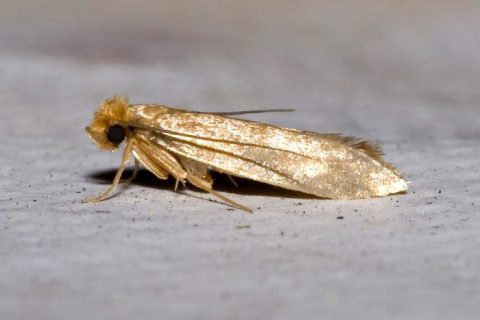Any Questions? Call us today!
All You Need To Know About Clothes Moths


All You Need To Know About Clothes Moths
Moths may seem like harmless insects that do not bite people or transmit any diseases (like other pests), but they can become very annoying and destructive if they get in contact with people’s clothes and outdoor fruits and tree leaves.
They are winged insects related to the butterfly, part of the order Lepidoptera. The dust on their wings actually consists of scales coming loose. These scales are the ones that give moths and butterflies their colourful wings. They come in various sizes and colours, and an interesting fact is that not the moths themselves destroy the clothes, but actually their larvae.
Female moths lay the eggs on clothes, and they particularly prefer clothes with stains, sweat or urine so that the larvae gets the needed vitamins. So an important step in preventing moths is to keep the clothes clean in your drawers. Outdoor moths lay their eggs on fruit trees, and the larvae will destroy the fruits and the leaves of the trees. And there are also some species that will eat the flours or grains stored in your pantry.
Common Species of Moths
When it comes to home moths, the most common ones are:
The Brown House Moths – they grow up to 14 mm long and are brown with some darker spots
The Common Clothes Moths – they are straw coloured with no other markings. They grow about 8 mm long and have wings fringed along the bottom
The White Shouldered House Moths – they have dark-coloured forewings with a few light spots and can have up to 10 mm in length. Their holes are circular, unlike the Common Clothes Moths which make irregular shaped holes in clothes
The Case-Bearing Clothes Moths – they have a brown head and mottled wings, and can grow up to 10 mm long. You will not find these ones on your clothes as they are not interested in fabrics. They are scavengers looking for food, so you might find them in your pantry
The females of these indoor species make up to 50 eggs within 3 weeks and die afterwards. The eggs will hatch within 10 days if the weather is warm or within one month if it’s cold. They usually make one generation per year.
The most common species of outdoor moths are:
The Coddling Moth – they are grey with brown patches on their forewings and golden or copper markings. They like to feed on ripened fruits, destroying people’s crops
The Gypsy Moth – the females of this species are white with dark bands, while the males are light brown and have dark wings. They like to feed on the leaves of various types of trees, and when in large numbers they can completely defoliate a tree
The Winter Moth – they are smaller moths coloured in brown. They feed on new tree buds in the early spring, so then when the leaves start to emerge they are already riddled with holes. If there are enough insects, they can also defoliate trees or ornamental plants
Outdoor moths lay their eggs in branches, trunks or leaves. Some species emerge in three weeks and start feeding with the fruits, while others only emerge during the spring and feed on the growing trees and leaves.
Signs of Moths
Moths are usually attracted by lights at night, and that’s how they can get in your home or back yard. The signs of moth infestation are:
- Tunnels or silky furrows on wool clothing and fabrics
- Holes in clothes
- Furs that shed
- Small tubes in fabrics, which are actually the larvae casings
- Crusty deposits on rugs or clothing
- Adult moths flying near sources of light
- Holes in plastic food bags
- Eggs or larvae inside packages of food
- Moths crawling or flying through the pantry
How To Get Rid of Moths
While moths do have a role in the nature (they are pollinators, picking up pollen on their hairy bodies and transferring from one flower to another), they become pests when they start feeding on clothes or crops. So it’s important to get rid of them as soon as possible and prevent them from laying new eggs.
If you have just 2 or 3 moths in your home, you can use moth traps or add moth repelling products in your closets. If you wash your clothes and vacuum the carpets and drapes, you might be fine. But when it comes to outdoor moths or to serious indoor infestations with tens of insects, then you need to call a pest control company right away. Our experts will use professional-grade sprays and deterrents to get you moth-free in no time.
Safeguard Pest Control
Whether you have issues with bees, termites, lawn grubs, mice, rats, geckos, fleas, mosquitoes, flies, bed bugs, Silverfish, pantry pests or ticks, we are here to help! We are in business for more than 30 years now and had hundreds of satisfied customers all over the Sunshine Coast of Australia.
Our technicians are well trained and experienced, and we only use substances that are certified and safe for humans, for pets and for the environment. We offer pest control solutions to both residential and commercial areas, as well as to schools and hospitals.
Get Rid of Bees Now!
If your home or yard are seriously infested by these insects, then it’s time to call a specialist! Book your Safeguard ticks treatment now by calling 07 5477 6675 or emailing info@safeguardpestcontrol.com.au and allow us to protect your family against moths.
Use the form below to request a Free Estimate . Requests are answered within 4 hours or less.
